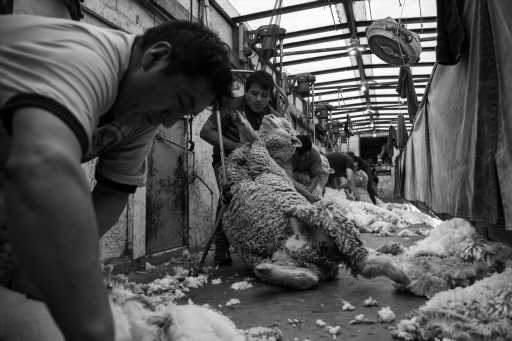On a sunny spring day in early March, thousands of Western Slope sheep line up in a corral unknowingly waiting for their annual haircut. Herders gently prod the animals to follow one another up a ramp and into mobile shearing plants where professionals with Hoopes Sheep Shearing, owned by third-generation shearer Cliff Hoopes, wait to harvest their fluffy white wool.
The buzz of generators powering the tools and baling equipment drowns out the otherwise lively environment inside the plants, where tunes like Men At Work’s “Down Under” and Doja Cat’s “Kiss Me More” set the pace for shearers, most of whom hail from Australia, New Zealand, the Falkland Islands, and other places outside of the United States with large sheep industries.
According to Hoopes, his workers are the best in the biz, each handling up to 200 animals per day.
Their job requires both strength and grace, as they maneuver the animals and shave in long strokes across the body of the animals, careful not to nick them. The whole process takes just two or three minutes, after which the sheep are let free in a pen while the massive piles of wool are sorted by workers known as “classers” according to length and fineness.
The shorter strands and other scraps land in wooden bins, while the long, fine strands get baled together. The latter is the luxurious stuff, optimal for suits and other premium products. Fresh off the animal, the wool is bright white and wavy – the mark of pristine condition — and so soft you could fashion the queen’s panties from it. That’s the running joke among the ranchers, anyway.
This scene is commonplace on the Western Slope in the spring, as ranchers in the state’s sheep farming hub seek to trim their flock before lambing season. Since wool doesn’t shed, shearing is important to prevent it from overgrowing. Plus, it’s big business.
Colorado is a leader in domestic wool production, accounting for 2,180,000 pounds in 2021 – second only to California – according to the United States Department of Agriculture. And the state ranks sixth in lamb production, a more lucrative crop by dollar volume.
Despite being a powerhouse, Colorado’s sheep industry has been shrinking over the last several decades. According to Bonnie Brown, executive director of the Colorado Wool Growers Association, pressure from government regulation and competition with imports is cutting into already thin margins. Because of that fewer young Americans now join the family business, meaning many multigenerational farms may not last to see the next one.
“In ag as a whole, you don’t see the next generation staying on as much as you used to,” Brown said. The average age of a farmer for produce and livestock in Colorado is 57.6 years old, per the USDA.
And as the number of sheep farmers declines, so too does the number of Hoopes’ potential clients.
“When I started shearing 41 years ago, there was approximately 20 million head of sheep and now there’s less than 5 (million),” he said.
Brown pointed out that there are some young producers who are innovating and excited to keep going, but in general, she sees society as a whole turning away from production agriculture.
Hoopes, too, finds some agricultural jobs at odds with American working culture. Most of the people he employs come to the United States on visas from sheep meccas where rearing and shearing are a way of life. The shearers tour the globe lending their craft to farmers in the U.S., Europe, South America and beyond.
“There’s not enough Americans to do what we do,” he said. “It’s a hard life, it’s a real hard life. It’s not for everyone.”
In January, Hoopes and his crew begin their annual state-to-state tour, hauling three shearing plants, or long wooden trailers that can hold up to seven shearers at a time, and multiple wool presses that package the product. They travel to Colorado, Utah, Idaho, Wyoming and South Dakota until mid-June and in August, they hit the road again to visit small farms in Arkansas, Kansas, Missouri and more.
Come fall, Hoopes is back west to shear big flocks and tag the sheep, meaning shave their face, bum and belly. The end of the year is dedicated to butcher tagging wether sheep. In January, the tour starts all over again.
Hoopes, 57, comes from a long line of proud shearers. His grandfather was doing it until he was 86 years old. His father, James Hoopes, retired at age 71.
But he sees shearing as a dying art form, due in no small part to the generational gap. Hoopes’ two sons “want nothing to do” with the family business, he said. By his own volition, Hoopes aims to keep the business running another 20 years.
“As long as there’s sheep to be sheared I’ll stay in the business,” he said. “When I’m done, Hoopes Sheep Shearing is done.”
Subscribe to our weekly newsletter, In The Know, to get entertainment news sent straight to your inbox.
Source: Read Full Article





